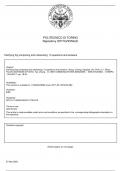POLITECNICO DI TORINO
Repository ISTITUZIONALE
Clarifying fog computing and networking: 10 questions and answers
Original
Clarifying fog computing and networking: 10 questions and answers / Mung, Chiang; Sangtae, Ha; Chih Lin, I; Risso,
FULVIO GIOVANNI OTTAVIO; Tao, Zhang. - In: IEEE COMMUNICATIONS MAGAZINE. - ISSN 0163-6804. - STAMPA.
- 55:4(2017), pp. 18-20.
Availability:
This version is available at: 11583/2679592 since: 2017-09-10T02:50:56Z
Publisher:
IEEE
Published
DOI:10.1109/MCOM.2017.7901470
Terms of use:
openAccess
This article is made available under terms and conditions as specified in the corresponding bibliographic description in
the repository
Publisher copyright
(Article begins on next page)
27 May 2020
, Tutorial
Clarifying Fog Computing and Networking: 10
Questions and Answers
By Mung Chiang, Sangtae Ha, Chih -Lin I, Fulvio Risso, and Tao Zhang
1. What Is Fog Computing and How Is It Different from Edge Computing?
Fog computing is an end-to-end horizontal architecture that distributes computing, storage, control, and
networking functions closer to users along the cloud-to-thing continuum. The word “edge” may carry different
meanings. A common usage of the term refers to the edge network as opposed to the core network, with
equipment such as edge routers, base stations, and home gateways. In that sense, there are several differences
between fog and edge. First, fog is inclusive of cloud, core, metro, edge, clients, and things. The fog
architecture will further enable pooling, orchestrating, managing, and securing the resources and functions
distributed in the cloud, anywhere along the cloud-to-thing continuum, and on the things to support end-to-
end services and applications. Second, fog seeks to realize a seamless continuum of computing services from
the cloud to the things rather than treating the network edges as isolated computing platforms. Third, fog
envisions a horizontal platform that will support the common fog computing functions for multiple industries
and application domains, including but not limited to traditional telco services. Fourth, a dominant part of edge
is mobile edge, whereas the fog computing architecture will be flexible enough to work over wireline as well as
wireless networks.
2. Is Fog Just a Smaller Cloud?
First, the size of the fog is flexible — it can range from a single small fog node to large fog systems comparable
to existing clouds, depending on the application needs. While fog will bring many cloud-like services closer to
end users and can have smaller footprints than the cloud, it has a different vision from that of smaller or mini-
clouds. Mini-clouds tend to be designed as isolated computing platforms. Fog envisions a seamlessly integrated
cloud-fog-thing architecture to enable computing anywhere along the cloud-to-things continuum. Fog-to-cloud
and fog-to-fog interactions will therefore be a focus of an end-to-end fog computing architecture to distribute
computing functions, and then manage, pool, orchestrate, and secure the distributed resources and functions.
Fog may form a hierarchical architecture between the cloud and the things, with fog nodes at different
architectural levels collaborating with each other to support end-to-end applications. Fog also concerns the
control of cyber-physical systems and D2D communication, in addition to computation and storage in clouds,
big or small.
3. Is Fog Equivalent to IoT?
Fog is an architecture. The Internet of Things (IoT) often refers to a set of services and applications. An
architecture decides the allocation of functionalities. It formulates and answers questions such as “who does
what, and at what timescale and location?” An architecture supports many applications, some in existence




